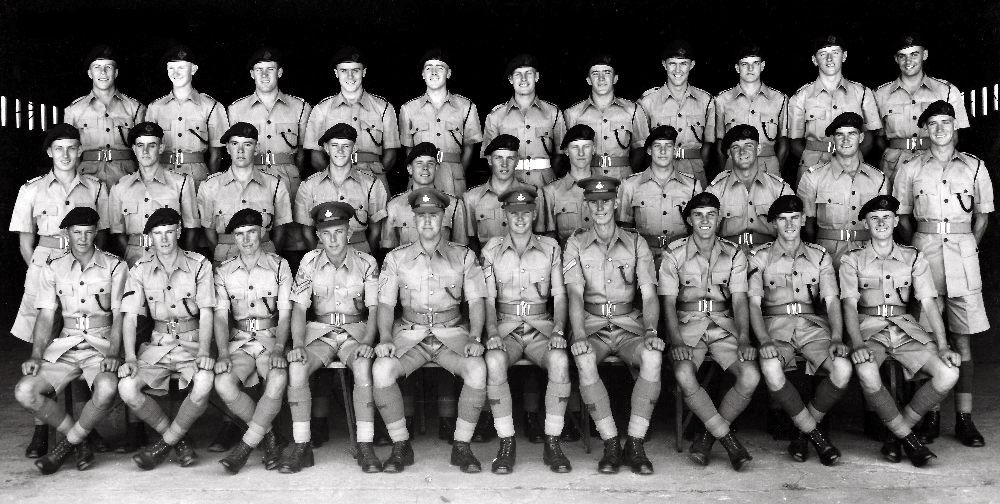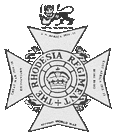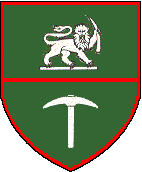Rhodesia Regiment  Army Home Page
Army Home Page Site Home Page
Site Home Page  Contact Us
Contact Us
Major Frank Johnson, in terms of a contract with Cecil Rhodes, undertook to assist in occupying
Mashonaland for the British South Africa Company. For this purpose he raised the Pioneer Force which in 1890, as part of the Pioneer Column
led by Selous and commanded by Colonel Pennefather, marched north from the Cape Colony to open up Rhodesia by cutting the road and preparing
fortified posts.
The Pioneer Force, on arrival at Fort Salisbury on 12th September, 1890, disbanded and the men became the first settlers
in Mashonaland. The other part of the Pioneer Column, the British South Africa Company's Police, under the command of Colonel Pennefather and Major
Forbes, both of the 6th Royal Inniskilling Dragoon Guards, was not dispersed but was given the role of safeguarding the line of
communication to the new Rhodesia.
These Police, the BSAP of to-day, were thus the first Regular Forces in Rhodesia and
the Pioneer Force settlers its first Citizen Soldiers. These settlers, formed into a Volunteer Unit, the Mashonaland Horse,
took part in the Matabele War in 1893 which resulted in the annexation of that country and its amalgamation with Mashonaland to form the
future Southern Rhodesia. The Mashonaland Horse was renamed the Rhodesia Horse. The Rhodesia Horse and other volunteer Units took part in suppressing
the Matabele and Mashona Rebellions of 1896.
With the populating of the Territory, the Southern Rhodesia Volunteers were formed into an Eastern and Western Division with Headquarters in
Salisbury and Bulawayo respectively. The first unit named as the Rhodesia Regiment was formed from
Volunteers and saw service in the South African War of 1899-1902 in guarding the Limpopo Border, assisting in the Relief of Mafeking and at
Elands' River. (The flag flown at Elands' River is now in the Anglican Cathedral, Salisbury.)
On the conclusion of the South African War the Rhodesia Regiment was disbanded and the South-ern Rhodesia Volunteers
and BSAP constituted the Defence Force of Southern Rhodesia. In 1914 two battalions of the Rhodesia Regiment were formed from the
Southern Rhodesia Volunteers; the 1st serving the German South West Africa and the 2nd in Tanganyika.
Apart from these two battalions members of the Southern Rhodesia Volunteers and BSAP
served with many Colonial and British Units on other fronts.
In 1926 with the re-organisation of Southern Rhodesia's Defence System
a Territorial Active Force of two battalions was formed and named the
Rhodesia Regiment; the 1st Battalion at Salisbury with a company at
Umtali and the 2nd at Bulawayo.
In 1939, due to the high leadership qualities of the Regiment's
personnel and to prevent possible large scale man-power loss to
Southern Rhodesia, it was decided not to use the two battalions as such
in the second world war.
In consequence, men of
the Regiment served with the East and West African Units, with British
Units and Commonwealth Forces on most fronts in the War. Two battalions
raised from older men acted as Home Guard Units in Southern Rhodesia.
In 1947, His Majesty King George VI, in recognition of the widespread
service of the personnel of the Regiment and the fine reputation
Rhodesians had gained for themselves, conferred the title "Royal" and
honoured the Regiment further by becoming its Colonel in Chief. Today,
Her Majesty Queen Elizabeth II is the Colonel in Chief.
After the War, school cadet units in Southern
Rhodesia were formed into two cadet Battalions and brought into the
Regiment as the 3rd and 4th Battalions. The designation of the cadet
battalions was later changed to 12th and 13th Battalions.
Defence, with the advent of Federation in 1953,
became Federal and the 3rd (Northern Rhodesia) Battalion was formed
with Headquarters in Kitwe and companies at Chingola/Bancroft,
Mufulira, Kitwe, Luanshya, Ndola, Broken Hill and Lusaka. School Cadet
Units in Northern Rhodesia were formed into the 14th Battalion.
In June 1959, the Fourth Battalion was raised in Southern Rhodesia
giving a total of four active Territorial Battalions in the Royal
Rhodesia Regiment. In March 1960, the 5th, 6th and 7th Battalions were
formed as Reserve Units; the 7th on the Copperbelt in Northern
Rhodesia.
The Regimental Depot is at Llewellin Barracks outside Bulawayo.
From the Regiment originated the Southern Rhodesia
Air Force (now the RRAF), the Southern Rhodesia Artillery (now the
Governor General's Troop), and Southern Rhodesia Signals. These units
were originally the learner pilots of the 1st Battalion, the Light
Battery of the 1st Battalion, the Armoured Car Squadron of the 2nd
Battalion and the Engineer and Signal sub-units of both the 1st and 2nd
Battalions.
The Regiment's badge is the Maltese Cross,
surmounted by a Crown; in the centre of the Cross is the Rhodesian
heraldic lion supporting a tusk of ivory from the old British South
Africa Company's Coat of Arms. The Regimental col-ours are Black, Green
and Red. In the past, the 1st and 2nd Battalions have had pipe bands.
An association dating back to the first World War,
when men from the Regiment served with the Kings Royal Rifle Corps, has
resulted in the Royal Rhodesia Regiment becoming affiliated to that
unit. The KRRC was raised in 1755 as a Colonial Unit in the American
Colonies with the title, "The Royal American Regiment".
E Company 3rd (NR) Battalion Royal Rhodesia Regiment, was adopted on
11th September, 1960 when Lusaka became a City and it is known as E
(City of Lusaka) Company.
The Honorary Colonel, Colonel F. B. Canning-Cooke,
O.B.E., T.D., was the first Commanding Officer of the Battalion and has
had a long connection with the Territorial Forces in the United Kingdom
and India. At the time that this article was written the Officer Commanding was Lieutenant Colonel F. E.
Milligan who was an ex-regular Officer of the Indian and Pakistan armies.
DEPOT THE ROYAL RHODESIA REGIMENT, No. 4 PLATOON "A" COMPANY, 22nd INTAKE, 1958

Back: Rfn. Berresford. W. M. P., Rfn. Manson-Bishop, R. S., Rfn. Barnard, J. A., Rfn. Tastard, A. P., Rfn. Kay, R. G., Rfn. Hapgood‑Strickland, R. R., Rfn. Flanagan. K. G. B., Rfn. Du Toit. A., Rfn. Madgwick, R. L., Rfn. McCarthy, O. J. S., Rfn. Brown, W.G.
Centre: Rfn. Stutely, M. J., Rfn. Norvall, F. A., Rfn. Viljoen, J. A., Rfn. McBeath, R. W., Rfn. Hall, P. B., Rfn. Gey Van Pittius, J. J.,
Rfn. Keenan, J. D., Rfn. Oschger, J. H., Rfn. Eggleston, J. K., Rfn. Enslin, P. A., Rfn. Girdlestone, R. J. F.
Front: Rfn. Comer-Crook, C. Fă, Rfn, Anderson, M., Cpl. McGoey, M. J., Cpl. Pitt, I. W. T., Sgt. Shute, M. D., Cpl. Micklesfield, A. G.,
Rfn. Roux, A. K., Rfn. Foster, P. C., Rfn. McEnery, P. J.

















